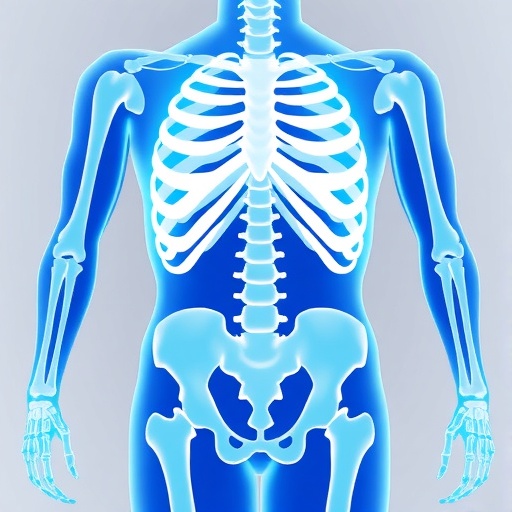The intricate links between obesity and bone health are emerging as a frontier in metabolic research, underscoring a complex interplay with profound clinical implications. As obesity rates surge globally, particularly among vulnerable populations such as children, adolescents, and postmenopausal women, the consequences extend far beyond cardiovascular and metabolic disorders. Recent investigations illuminate how excess body fat accumulation and associated conditions like non-alcoholic fatty liver disease (NAFLD) orchestrate a detrimental impact on skeletal integrity, reshaping our understanding of bone metabolism in the context of systemic metabolic dysfunction.
Obesity is traditionally viewed through the lens of energy imbalance and adiposity; however, its consequences permeate diverse physiological systems, including the skeletal framework. Bone remodeling, a tightly regulated balance between osteoblastic bone formation and osteoclastic bone resorption, is increasingly recognized to be modulated by metabolic alterations intrinsic to obesity. The pathophysiological nexus linking obesity and bone health is multifactorial, contingent upon systemic inflammation, hormonal imbalances, mechanical loading variations, and cellular signaling pathways altered by adipose tissue dysfunction.
At the molecular level, adipokines such as leptin and adiponectin, secreted by hypertrophic adipose tissue, emerge as pivotal regulators of bone cell activity. Leptin, often elevated in obese individuals, has a dualistic role; it influences bone metabolism both centrally via hypothalamic pathways and peripherally by direct effects on osteoblasts and osteoclasts. Elevated leptin levels paradoxically correlate with decreased bone formation in certain contexts, suggesting a disruption in normal signaling cascades. Conversely, adiponectin demonstrates generally beneficial effects on bone, promoting osteogenic differentiation and inhibiting osteoclastogenesis, yet its levels are reduced in obesity, potentially exacerbating bone loss.
Chronic, low-grade systemic inflammation is a hallmark of obesity and NAFLD, fundamentally altering bone remodeling dynamics. Pro-inflammatory cytokines such as tumor necrosis factor-alpha (TNF-α), interleukin-6 (IL-6), and interleukin-1 beta (IL-1β) mediate increased osteoclastic activity and decreased osteoblast function, skewing the delicate remodeling balance toward net bone resorption. The persistent inflammatory milieu also disrupts the bone marrow microenvironment, impairing mesenchymal stem cell differentiation into osteoblasts, thereby diminishing bone formation and contributing to osteopenia and osteoporosis.
Insulin resistance, another cardinal consequence of obesity, exerts a profound influence on bone metabolism through mechanisms involving impaired signaling pathways and altered glucose utilization by bone cells. Insulin acts as an anabolic agent in bone, promoting osteoblast proliferation and differentiation. Resistance states attenuate this effect, compromising bone formation. Furthermore, hyperinsulinemia may dysregulate osteoprotegerin (OPG) and receptor activator of nuclear factor kappa-Β ligand (RANKL) expression, pivotal determinants of osteoclast differentiation and activity, thereby influencing bone resorption rates.
NAFLD, frequently coexisting with obesity, contributes an additional layer of complexity affecting skeletal health. Hepatic steatosis and inflammation precipitate systemic metabolic disturbances, including dyslipidemia and altered hormone metabolism, which indirectly compromise bone integrity. The liver’s role in producing insulin-like growth factors and regulating vitamin D metabolism becomes impaired in NAFLD, attenuating key anabolic cues necessary for maintaining bone mass. Notably, vitamin D deficiency is prevalent in obese and NAFLD populations, further impairing calcium homeostasis and bone mineralization.
Emerging evidence underscores the significance of gut microbiota dysbiosis as a mediator between obesity, NAFLD, and bone health. Alterations in the gut microbial composition influence systemic inflammatory status, nutrient absorption, and the generation of metabolites such as short-chain fatty acids, which hold regulatory functions in bone remodeling. Dysbiosis fosters increased intestinal permeability, facilitating systemic endotoxemia that amplifies inflammatory cascades detrimental to bone integrity. Additionally, gut microbiota modulations may impact vitamin D metabolism and calcium absorption, compounding factors leading to skeletal fragility.
Mechanotransduction, the process by which bone cells sense and respond to mechanical stimuli, is also affected in obesity. Although increased body weight theoretically imposes greater mechanical loading on the skeleton, promoting bone formation, adipose tissue infiltration into bone marrow and systemic inflammation attenuate mechanosensitivity. The resultant impaired mechanotransduction blunts osteoblastic activity and favors adipogenesis over osteogenesis within the bone marrow niche, culminating in compromised bone quality despite increased mass.
From a clinical perspective, the interplay between obesity and bone health manifests as paradoxical phenomena. Higher body mass index (BMI) has, in some studies, been associated with increased bone mineral density (BMD), attributed to mechanical loading. However, accumulating evidence reveals that obesity, especially in the context of metabolic dysfunction and NAFLD, predisposes to deteriorated bone microarchitecture and increased fracture risk. This apparent paradox necessitates a paradigm shift in assessing skeletal risk profiles in obese individuals, moving beyond BMD metrics to incorporate bone quality and systemic metabolic status.
Therapeutic strategies targeting the detrimental skeletal consequences of obesity must address the underlying systemic perturbations. Weight loss interventions, while beneficial, can adversely affect bone density if not carefully managed, indicating a need for integrated approaches that preserve or enhance bone mass during metabolic improvement. Pharmacological modulation of adipokines, anti-inflammatory agents, and interventions targeting gut microbiota hold promise but require rigorous clinical validation.
The complex crosstalk between adipose tissue, liver metabolism, and bone cellular activities underscores a multidimensional network of molecular pathways and systemic factors. Advances in omics technologies and systems biology approaches are unraveling these intricate relationships, paving the way for personalized medicine strategies that mitigate the compounded risks of obesity and NAFLD on skeletal health. Understanding the nuances of these interactions is crucial for developing targeted interventions that not only ameliorate metabolic diseases but also preserve skeletal integrity.
Future research is poised to delve deeper into the signaling mechanisms by which obesity-linked metabolic disturbances propagate skeletal deterioration. Investigations into the roles of novel adipokines, osteoimmunological interactions, and epigenetic modifications in bone cells may unveil new therapeutic targets. Moreover, elucidating the influence of lifestyle factors, including diet composition and physical activity, on the obesity-bone axis will inform holistic management paradigms.
In a public health context, the rising tide of pediatric and adolescent obesity heralds a looming burden of skeletal morbidity in younger populations. Early-life metabolic insults potentially program lifetime bone health trajectories, emphasizing the urgency of preventive strategies that integrate metabolic and bone health preservation. Educational initiatives, screening programs, and interdisciplinary clinical pathways are imperative to mitigate long-term skeletal complications in obese individuals.
The multifaceted impact of obesity and NAFLD on bone represents a compelling example of how systemic diseases intersect to compound health risks. As our mechanistic insights deepen, translating these findings into clinical practice offers hope for improved diagnostic accuracy, prognostic assessments, and treatment efficacy. Ultimately, integrating skeletal health considerations into the broader framework of metabolic disease management will enhance patient outcomes and quality of life.
In conclusion, the intricate and bidirectional relationships linking obesity, NAFLD, and bone health underscore the necessity of a comprehensive understanding of metabolic and molecular interactions. Obesity-related chronic inflammation, adipokine dysregulation, insulin resistance, gut microbiota alterations, and impaired vitamin D metabolism collectively orchestrate skeletal fragility. Addressing these factors through targeted research and multidisciplinary care is paramount to counteracting the silent yet significant threat obesity poses to the human skeleton.
Subject of Research: The interplay between obesity, non-alcoholic fatty liver disease (NAFLD), and their combined impact on bone metabolism and skeletal health.
Article Title: The impact of obesity on bone health: molecular pathways, metabolic interactions, and associated pathologies.
Article References:
Bagherifard, A., Hemmatyar, A., Khosravi, K. et al. The impact of obesity on bone health: molecular pathways, metabolic interactions, and associated pathologies. Int J Obes (2025). https://doi.org/10.1038/s41366-025-01907-1
Image Credits: AI Generated
DOI: https://doi.org/10.1038/s41366-025-01907-1
Tags: adipokines and bone metabolismchildren and obesity-related bone issuesclinical implications of obesity on boneshormonal imbalances in obesitymechanical loading and bone healthmetabolic dysfunction and bone remodelingmolecular mechanisms of obesity’s impact on bonesnon-alcoholic fatty liver disease and skeletal effectsobesity and bone healthosteoblastic and osteoclastic activity in obesitypostmenopausal women and bone healthsystemic inflammation and skeletal integrity





